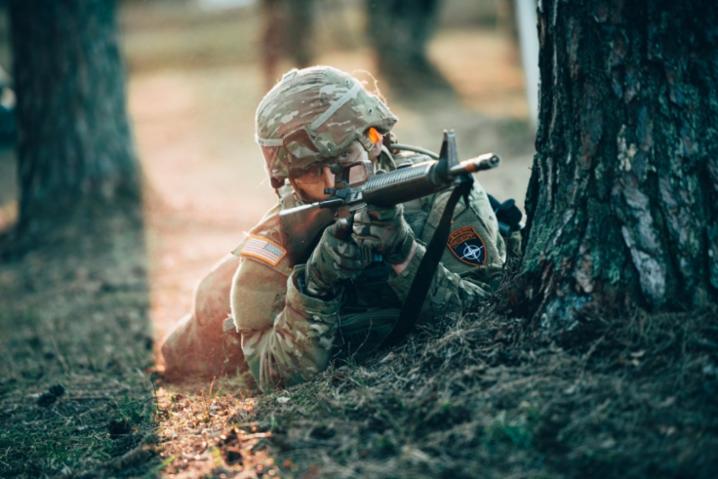Following the outbreak of COVID-19, the U.S. European Command (USEUCOM) quickly reduced the scope and size of U.S.-led multinational exercise Defender-Europe 20 to reduce risk on participating forces and local populations. It is one example of how Allies and partners are working together to adapt to this crisis, while maintaining readiness.
While COVID-19 continually creates challenges across all segments of society, the U.S. military in Europe continues to stand the watch.
Approximately 72,000 military men and women and civilians, who live and work across the European theatre, are maintaining warfighting readiness and deterrence, while taking appropriate measures to prevent the further spread of the virus.
“Never has there been a more important time for our military to remain ready and responsive than during this ongoing public health crisis,” said Maj. Gen. Jeffrey Kramer, director of USEUCOM’s exercises and training programmes. “The ability to respond quickly and to adjust at a moment's notice is instrumental in our ability to maintain our readiness. The current environment with this public health crisis has demonstrated our ability to do just that.”
Regular training and coordination with Allies and partners enhances already strong relationships and improves our ability to respond together in times of need.

The response to the COVID-19 outbreak during Exercise DEFENDER-Europe 20 is one example of how Allies and partners worked together in a crisis and adapted to defend the health and safety of personnel and communities.
With more than 6,000 service members deployed from the United States to Europe, DEFENDER-Europe 20 demonstrated the ability to move more than 3,000 pieces of equipment from ports to training areas and more than 9,000 pieces of Army prepositioned stock from storage sites to training areas. When the virus outbreak expanded around the globe, leadership from all participating units came together to quickly mitigate risks, which included modifying and canceling events.
“While we did not make it through all of the elements of Exercise DEFENDER-Europe 20, we learned a number of lessons that have enhanced our already existing military strengths,” Kramer said.
Mobility in Europe is all about understanding processes, requirements, and accessibility. Despite DEFENDER-Europe 20 being modified, planning efforts alongside NATO Allies and European Union partners proved just how critical open lines of communication are to successfully facilitating logistical movements from the United States and then throughout the continent with speed and relevance.
Gen. Tod Wolters, commander of U.S. European Command, noted that in light of modifying and reducing the scope and size of DEFENDER-Europe 20, important lessons were still captured.
“There are valuable lessons learned that we've embraced along the way,” Wolters said. “The foundational aspects of cooperation and planning that went into each component of our exercises was a gain in training, and it certainly built trust.”
Linked exercises to DEFENDER-Europe 20, along with a number of other events set to take place into the summer, were cancelled, modified or delayed in order to safely execute the intended training. Between now and the end of May, exercise planners from all components across the European theatre continue to review options and other ways to practice manoeuvres to enhance command-and-control elements.
We've innovated to find new ways to communicate with one another more efficiently as a result of the virus outbreak
While the health of USEUCOM forces and our communities remains the top priority, the ability to continue to work closely with Allies and partners to develop next steps once the COVID-19 outbreak has passed remains a focal point for exercise planners.
“We have learned a great deal from the adjustments that were made for DEFENDER-Europe 20 and other activities we had planned into the spring,” said Col. William Donnelly, lead exercise planner for USEUCOM's training and exercise directorate. “We've stayed in regular communication with our service components, Allies and partners to talk through the various methods to keep our programmes going, despite the challenges associated with the virus outbreak.”
Kramer added, “Our components continue to impress with their agility and flexibility, while also caring for their own personnel affected by the virus and those of the host nations where we live and work.”
U.S. Army Europe leveraged the planning and initial aspects of Exercise DEFENDER-Europe 20 to develop and validate practical solutions for interoperability, such as in-transit visibility tracking systems between the United States and the Netherlands and use of port-management teams from the United Kingdom to facilitate operations.
That cooperation and the long-standing relationships we have with Allies and partners also guaranteed the ability to rapidly deploy much larger numbers of troops and equipment from CONUS (the contiguous United States), receive them at multiple seaports and airports, and get them to a point of strategic need in Europe.
Alongside Allies and partners, it is imperative that nations continue to improve upon mobility through investments in prepositioned equipment and munitions, strategic mobility assets, access and basing agreements, and synchronisation of commercial logistics distribution networks. This level of cooperation between the United States, NATO, and the EU is key to continuing strong and steadfast deterrence throughout the region.
To further bolster training and readiness, U.S. Army personnel in Germany, Poland and other locations continue to conduct individual and unit-level training, such as gunnery exercises focused on maintaining tactical proficiency.
Across Europe and the waters in USEUCOM’s area of responsibility, the U.S. Navy has forward deployed guided-missile destroyers underway on patrols, providing vital maritime security and deterrence. Maritime patrol and reconnaissance aircraft, such as P-8 Poseidons, are patrolling in the Black Sea, Eastern Mediterranean Sea and Arctic regions, remaining ready and responsive.
Additionally, planners and operational teams are communicating through secure video-teleconferencing and regular phone calls and emails to improve communication practices across all domains during the current virus outbreak.
“We've innovated to find new ways to communicate with one another more efficiently as a result of the virus outbreak,” said Donnelly, “and that will be a good thing in the long run because it will help us develop more robust plans for managing training and events in the future.”






Leave a Reply